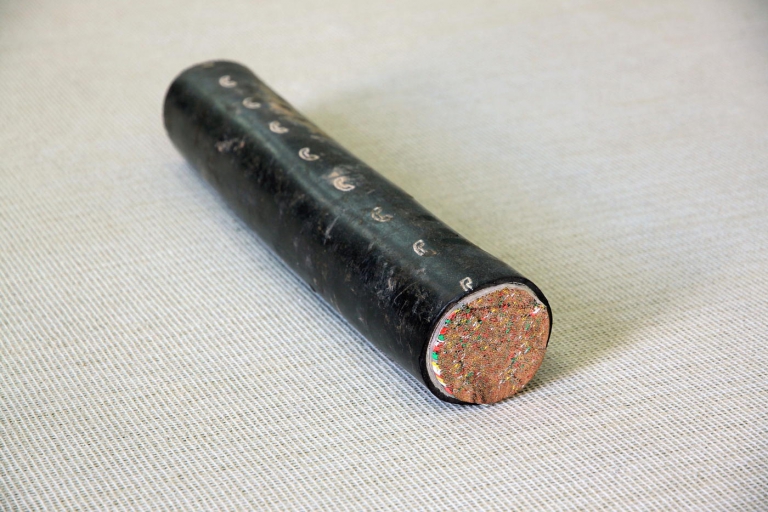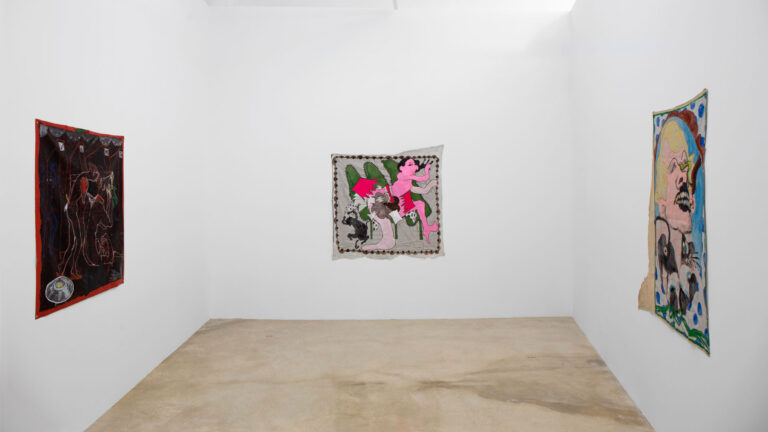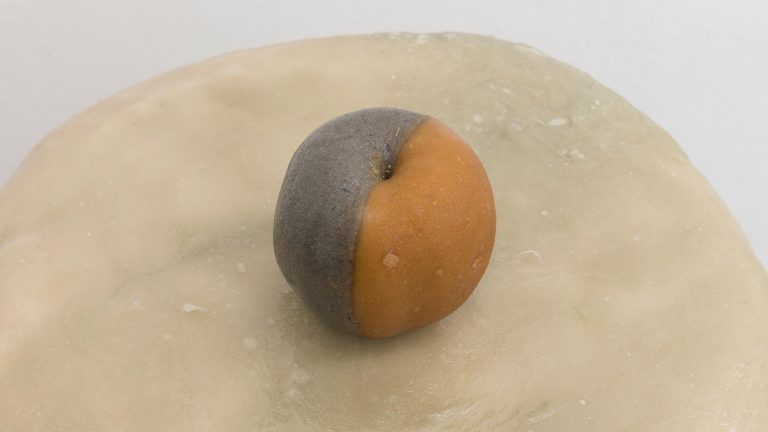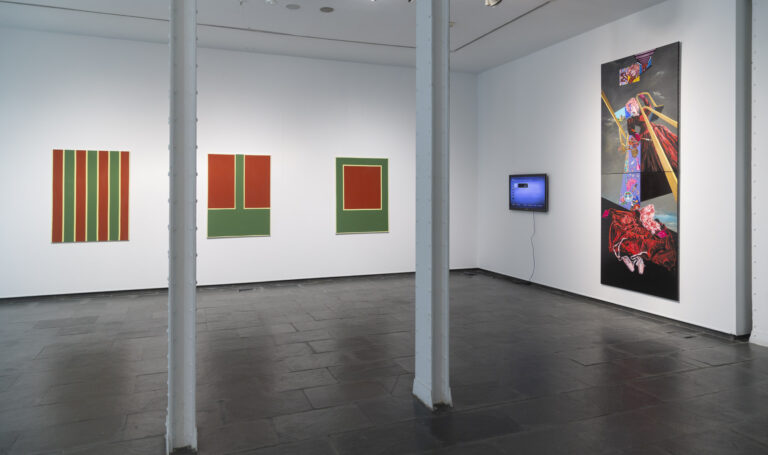Artist: Antonio R. Montesinos
Exhibition title: RLX. About the place I am
Curated by: Juan Francisco Rueda
Venue: Galería Isabel Hurley, Malaga, Spain
Date: November 18 – December 30, 2021
Photography: all images copyright and courtesy of the artist and Galería Isabel Hurley, Malaga
Antonio R. Montesinos has for many years been involved in a project which has taken on the metaphorical condition of a voyage. RLX, about the place I am, could be considered as the final leg of that voyage, which seeks recognition as a product of the so-called Relax Style, that is of the collective imagination and the different productions (architecture, spaces for entertainment, graphic design, or infrastructures) that were linked to the leisure and tourism industries developed on the Costa del Sol from the middle of the 20th century and for several decades.
And he seeks recognition in this project not just – nor simply – as a native of Málaga but also as a descendant of migrants who moved from the interior to settle on the coast and take part in this socio-economic phenomenon that is a local symbol of progress-at-all-costs, taking advantage of the opportunities presented by the [mass] exodus of others at the time. His desire is also to place himself as a local who has experienced life in a region profoundly transformed by the impact of tourism and the speculation that accompanies it, and where different housing and demographic parameters in the urban framework become strained and even degraded.
This context or these repercussions, however, cannot erase the fascinating universe of forms that spring up, or the cultural value that nowadays many of these items assume, and yet which are under threat, as well as the formative quality of an urban environment built along the national highway 340 (hereinafter, the N-340). In the spirit of an art historian, Montesinos wishes to highlight the importance of this heterogeneous universe not only as a stylistic residue or artistic phenomenon but also as a transitory landscape: as much the result/product of a social, economic, and artistic process as a way to arrive at these factors in this route towards (self) comprehension.
Without doubt, his purpose is not simply to fashion himself as a new ode or to undertake an artistic review of the products of the Relax Style, taking part in a story projected like some local mythology, but rather to tackle it from the perspective of its implications for society and identity. The title of this exhibition reveals the very deep bond that Montesinos feels with the world of Relax, which has modified and shaped the place/territory that he feels as his own, in which he finds meaning or the origins of a way of being, a way of acting, a space where, without doubt, he is himself.
What Montesinos seeks to do is to cast over this object of study a new and different gaze, asking new questions that involve answers that can amplify, complete, or diversify both the interpretation and the critical fortunes thereof. From all of this, we can perhaps begin to understand the militancy that Montesinos shows regarding the intrinsic value of the world of Relax, and his conviction of its undoubted cultural worth.
The artist does not hide just how this heritage is the fruit of a radical modification in the conurbation of the Costa del Sol, that kind of ribbon development that hugs the length of the N-340, and which is officially known as “ZoMeCS” (the Metropolitan Area of the Costa Del Sol). Nor does he hide the origins nor the perverse and spurious offshoots of the economic phenomenon that sustains it, yet that is no obstacle to his accepting its transcendental and essential influence on himself – and on the area’s people, folk, or community – and his defence of many of its landmarks and of its material and symbolic culture, including documents of culture, anthropology, and identity.
The journey undertaken by Montesinos is, therefore, as much scientific – where the artistic praxis turns into social science – as emotional. Documents and memory seem to fuse together, in the same way that those elements or minutiae on which his questioning gaze is fixed act with the dual condition of being both clues and life lessons. As such, and as a companion on this journey, he has the support of this curator. Indeed, for both the artist and he who writes these lines, this exhibition represents the culmination of a decade in which the Relax Style has been a recurrent theme of conversation and of reflections which have illuminated several shared experiences of exhibitions, such as the Forging identities. Building stages project of 2019 in the Genalguacil museum village, artistic productions, and knowledge.
Indeed, many of these experiences have proven to be profoundly significant for this process of investigation, a veritable work in progress, which we see through the metaphor of a journey. So much is this the case that some of the stances, materials, and solutions that one can observe in RLX, about the place I am, come from these past experiences, reshaped for this moment. In RLX, about the place that I am, Montesinos joins together several characteristics and methods typical of his poetry with various notions from the Relax Style which he wants to emphasise, such as its natural style of unleashing a torrent, and borrowing of materials and architectural formulas from the vernacular tradition and the architecture of the Modern Movement, which blend in a way that is absolutely without prejudice, free, and even bizarre.
In this, the artist uses a style that is eminently sculptural and which breaks down some of the main iconic structures, and which is heavily loaded with personal life experiences, in a repertory of formal solutions, materials and stylistic features. On seeing these sculptural devices, such as the one inspired by the iconic Holiday Village of Marbella, one is reminded of Montesinos’ Inopias series of works, in which one can see a formula which is broadly representative of this latest work.
Faced with the mini-golf courses of the Hotel Mare Nostrum in Fuengirola, due to the way in which they are presented, appear the “graphic areas” to which he dedicated himself at the beginning of his artistic career. The use of MDF and a certain scenic development that some of the works displayed assume, allow us to find in them some of the guiding principles of the project Forging identities. Building stages as they relate to our understanding of them as different types of painted sets or stage machinery that have been built for the leisure and tourism industries on the Costa del Sol.
Montesinos, despite the precariousness of the materials which he chooses to use, succeeds in finding solutions and results that are really close to those that the creators of many of these buildings gave to them as their stylistic and formal stamp. The use of corrugated cardboard or cement in certain elements and details of his pieces is amazing, strongly evoking the procedures and materials employed in the third quarter of the Twentieth Century, the period in which the Relax Style occurred.
In other pieces he tries out new sculptural formulas making use of sheets of MDF in a way that imitates tridimensionality and the architectural. Similarly, in the style of trompe l’oeil – of stage design, and that sense of the decorative to which we referred before – he includes mythical materials which we identify with that world, for example the recreation of mosaic ceramic tiles which alludes to swimming pools and, specifically, to the San Miguel building in Fuengirola.
In other examples one could highlight the semantic character of some of the formal solutions, such as the hanging towel super imposed with several of the towers designed by Antonio Lamela for Playamar (Torremolinos) – which evidence also the new uses of photography (or perhaps one should talk directly of “post-photography”). These spontaneous actions of tourists who hang their beach towels on terraces and in windows form one of the most typical images of the summertime tourist destinations. That kind of gesture policy speaks to the phenomenon of beach tourism to which the Costa del Sol is so strongly linked, being as it is one of the paradigm destinations in our country.
Through some of the exhibits, Montesinos can demonstrate the profoundly plastic character of the architecture that is associated with the Relax Style, and which converts it in the proto post-modern, since part of it has, since the 1950’s, embodied tactile, sculptural, plastic values and meant a certain reformulation of the vernacular – all of which would come to be described as essential traits of the upcoming postmodernist architecture. The often-discussed act of breaking down those buildings into their component parts is key in showing us the vocabulary articulated in language or style, and in highlighting its meanings. Because of this, his works become exercises in metonymy. In other words, some of these fragments irrevocably name the building which shelters them.
Another question of great significance emanates from the ensemble of this RLX, about the place I am; a question which, to a certain degree, comes to validate or demonstrate the truth of the assumption that Montesinos makes, of how he is the place. We can refer here to how, throughout his career, his modus operandi has been mediated by a concept/behaviour of being adrift. Indeed, in the projects that deal with the Costa del Sol he seems to emulate some of the tendencies in the artistic praxis that have sought to interpret this territory.
This exhibition or his recent documentary Relax N-340, which premiered a few months ago in the University of Málaga’s Cultural Container, seem to emulate transcendental journeys, local and international, such as the short film in the style of a road movie which Guillermo Pérez Villalta shot in 1982 for the mythical TVE programme La Edad de Oro; or the trip taken in 1986 along the N-340 by Diego Santos, Carlos Canal and Juan Antonio Ramírez as the field study for the writing of the book which gives its name to the Relax Style and in which the same was theorised. This last-mentioned trip could be considered as a replica of the one undertaken by Robert Venturi, Steven Izenour and Denis Scott Brown along Las Vegas’s strip in 1968 and from which sprung Learning from Las Vegas, a book which introduced post-modernity. As such, to enter this exhibition is akin to undertaking an exercise in drifting, via landmarks and icons of the Relax Style, through this territory of Montesinos’s home. But as soon as you embark on this drifting you, just as the artist or the curator, will surely feel that you are in fact embarking on a journey through your own memory, and through that which gives you identity and through the place that you are.
Juan Francisco Rueda
Curator of the exhibition
Antonio R. Montesinos, RLX (Mare Nostrum), 2021, Mixed media, 101 x 180 x 15 cm
Antonio R. Montesinos, RLX (Mare Nostrum), 2021, Mixed media, 101 x 180 x 15 cm
Antonio R. Montesinos, RLX (Mare Nostrum), 2021, Mixed media, 101 x 180 x 15 cm
Antonio R. Montesinos, RLX. About the place I am, 2021, exhibition view, Galería Isabel Hurley, Malaga
Antonio R. Montesinos, RLX (Apartamentos San Miguel), 2021, Mixed media, 175 x 134 x 30 cm
Antonio R. Montesinos, RLX (Apartamentos San Miguel), 2021, Mixed media, 175 x 134 x 30 cm
Antonio R. Montesinos, RLX (Apartamentos San Miguel), 2021, Mixed media, 175 x 134 x 30 cm
Antonio R. Montesinos, RLX (Apartamentos San Miguel), 2021, Mixed media, 175 x 134 x 30 cm
Antonio R. Montesinos, RLX (Residencia Tiempo Libre), 2021, Mixed media, 120 x 158 x 90 cm
Antonio R. Montesinos, RLX (Residencia Tiempo Libre), 2021, Mixed media, 120 x 158 x 90 cm
Antonio R. Montesinos, RLX (Residencia Tiempo Libre), 2021, Mixed media, 120 x 158 x 90 cm
Antonio R. Montesinos, RLX (Residencia Tiempo Libre), 2021, Mixed media, 120 x 158 x 90 cm
Antonio R. Montesinos, RLX (Pez Espada), 2021, Mixed media, 68 x 500 x 15 cm
Antonio R. Montesinos, RLX (Pez Espada), 2021, Mixed media, 68 x 500 x 15 cm
Antonio R. Montesinos, RLX (Pez Espada), 2021, Mixed media, 68 x 500 x 15 cm
Antonio R. Montesinos, RLX (Pez Espada), 2021, Mixed media, 68 x 500 x 15 cm
Antonio R. Montesinos, Hijos del Relax (Pez Espada 1), 2020, Digital printing on barium paper, 49 x 34 cm; Hijos del Relax (Pez Espada 2), 2020, Digital printing on barium paper, 49 x 34 cm
Antonio R. Montesinos, RLX. About the place I am, 2021, exhibition view, Galería Isabel Hurley, Malaga
Antonio R. Montesinos, RLX (Playamar), 2021, Mixed media, 50 x 90 x 53 cm; 69 x 26 x 33 cm; 135 x 92 cm; 31 x 22’5cm
Antonio R. Montesinos, RLX (Playamar), 2021, Mixed media, 50 x 90 x 53 cm; 69 x 26 x 33 cm; 135 x 92 cm; 31 x 22’5cm
Antonio R. Montesinos, RLX (Playamar), 2021, Mixed media, 50 x 90 x 53 cm; 69 x 26 x 33 cm; 135 x 92 cm; 31 x 22’5cm
Antonio R. Montesinos, RLX (Playamar), 2021, Mixed media, 50 x 90 x 53 cm; 69 x 26 x 33 cm; 135 x 92 cm; 31 x 22’5cm
Antonio R. Montesinos, RLX (Playamar), 2021, Mixed media, 50 x 90 x 53 cm; 69 x 26 x 33 cm; 135 x 92 cm; 31 x 22’5cm
Antonio R. Montesinos, RLX (Playamar), 2021, Mixed media, 50 x 90 x 53 cm; 69 x 26 x 33 cm; 135 x 92 cm; 31 x 22’5cm
Antonio R. Montesinos, RLX (Playamar), 2021, Mixed media, 50 x 90 x 53 cm; 69 x 26 x 33 cm; 135 x 92 cm; 31 x 22’5cm
Antonio R. Montesinos, RLX (Playamar), 2021, Mixed media, 50 x 90 x 53 cm; 69 x 26 x 33 cm; 135 x 92 cm; 31 x 22’5cm
Antonio R. Montesinos, RLX (Playamar), 2021, Mixed media, 50 x 90 x 53 cm; 69 x 26 x 33 cm; 135 x 92 cm; 31 x 22’5cm
Antonio R. Montesinos, RLX (Tres Carabelas), 2021, Mixed media, 200 x 175 / 96 x 54 / Variable dimensions
Antonio R. Montesinos, RLX (Tres Carabelas), 2021, Mixed media, 200 x 175 / 96 x 54 / Variable dimensions
Antonio R. Montesinos, RLX (Tres Carabelas), 2021, Mixed media, 200 x 175 / 96 x 54 / Variable dimensions
Antonio R. Montesinos, RLX (Tres Carabelas), 2021, Mixed media, 200 x 175 / 96 x 54 / Variable dimensions
Antonio R. Montesinos, RLX (Tres Carabelas), 2021, Mixed media, 200 x 175 / 96 x 54 / Variable dimensions
Antonio R. Montesinos, RLX. About the place I am, 2021, exhibition view, Galería Isabel Hurley, Malaga
Antonio R. Montesinos, RLX. About the place I am, 2021, exhibition view, Galería Isabel Hurley, Malaga
Antonio R. Montesinos, RLX. About the place I am, 2021, exhibition view, Galería Isabel Hurley, Malaga
Antonio R. Montesinos, RLX. About the place I am, 2021, exhibition view, Galería Isabel Hurley, Malaga
Antonio R. Montesinos, RLX. About the place I am, 2021, exhibition view, Galería Isabel Hurley, Malaga
Antonio R. Montesinos, RLX. About the place I am, 2021, exhibition view, Galería Isabel Hurley, Malaga
Antonio R. Montesinos, RLX. About the place I am, 2021, exhibition view, Galería Isabel Hurley, Malaga













































